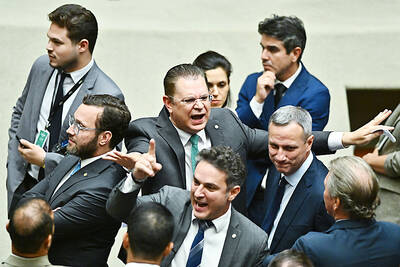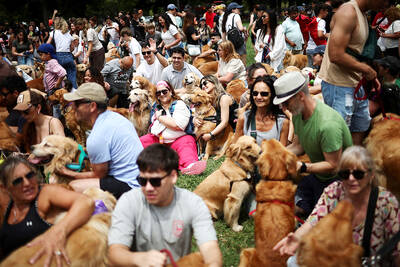Under pressure from frequent fliers alarmed over climate change, the airline industry has said it is “hellbent” on reducing emissions — but the technology needed to drastically reduce its carbon footprint is still out of reach.
In the past few months climate advocates have stepped up efforts to convince travelers to boycott air travel, with Swedish schoolgirl and campaigner Greta Thunberg spearheading the trains-over-planes movement and making flygskam, or flight shame, a buzzword in the Scandinavian country.
“The sector is under considerable pressure,” said Alexandre de Juniac, chief executive of the International Air Transport Association (IATA), whose members met this week in Seoul.

Photo: Reuters
The industry has been under fire over its carbon emissions, which at 285 grams of carbon dioxide emitted per kilometer traveled by a passenger far exceed all other modes of transport.
Road transportation follows at 158 and rail travel is at 14, according to European Environment Agency figures.
De Juniac said the industry was “hellbent” on lowering emissions, but the sector is also accused of underestimating its environmental impact, with the IATA chief lobbying heavily against a “green tax” on aviation backed by several countries including the Netherlands.
“Often these taxes are absorbed in the budgets of states and are spent on whatever they want, except the environment,” he said.
The International Civil Aviation Organization (ICAO) estimated that air transport is responsible for 2 percent of global carbon dioxide emissions — roughly equivalent to the overall emissions of Germany, according to consulting firm Sia Partners.
However, aircraft also emit particles, such as nitrogen oxides, which can trap heat at high altitude, meaning the industry is actually responsible for 5 percent of global warming, according to the Climate Action Network, an umbrella group of environmental non-governmental organizations.
The industry has committed to improving fuel efficiency by 1.5 percent per year from 2009 to next year and stabilizing its carbon dioxide emissions in preparation for a 50 percent reduction by 2050 compared with 2005.
It is a major challenge given that the number of passengers is expected to double over the next two decades to reach 8.2 billion in 2037.
Companies are banking on a new generation of less-polluting airplanes with updated engines, aerodynamic modifications and fittings that weigh less — among them tablets to replace heavy pilot manuals.
However, Shukor Yusof, an analyst with Malaysia-based Endau Analytics, told reporters that the industry had made progress, but “that all these technological advances to cut emissions are tough to implement quickly due to the nature of the industry hemmed by high costs and the fact that planes typically take decades before they are replaced.”
Philippe Plouvier, associate director of consulting firm Boston Consulting Group in Paris, said “the constant renewal of the fleet is a major part of it [cutting emissions],” adding that the latest models of large aircraft reduce carbon dioxide emissions by 20 to 25 percent.
“But that only solves around 30 percent of the problem,” he said.
The rest can only be resolved by developing sustainable biofuels or turning to electric power — technology which is currently impractical, Plouvier said.
Several airlines have begun testing biofuels, but production costs remain high and industry experts do not believe electric engines will be rolled out commercially for another two decades.
“Batteries today are still too big and heavy to be used as the main source of power for aircraft,” said Leithen Francis, managing director of Singapore-based aviation public relations agency Francis & Low.
“Aircraft today take off heavy — because the aircraft is carrying a full load of fuel — but then the aircraft uses up its fuel during the flight and lands light,” Francis said.
“Aircraft powered by batteries will take off heavy and then have to land heavy, so developing aircraft that can do that — without having a hard landings or causing structural damage to the airframe — will be a challenge,” Francis told reporters.
The ICAO said better management of air traffic can help and a new generation of more fuel-efficient airplane designs is predicted within five or 10 years.
However, time is not on the aviation industry’s side.
A landmark UN report last year concluded that carbon dioxide emissions must drop 45 percent by 2030 — and reach “net zero” by 2050 — if the rise in Earth’s temperature is to be checked at the safer limit of 1.5°C.
Plouvier said to meet the 2050 goal, the aviation industry “must start today and very quickly.”

PARLIAMENT CHAOS: Police forcibly removed Brazilian Deputy Glauber Braga after he called the legislation part of a ‘coup offensive’ and occupied the speaker’s chair Brazil’s lower house of Congress early yesterday approved a bill that could slash former Brazilian president Jair Bolsonaro’s prison sentence for plotting a coup, after efforts by a lawmaker to disrupt the proceedings sparked chaos in parliament. Bolsonaro has been serving a 27-year term since last month after his conviction for a scheme to stop Brazilian President Luiz Inacio Lula da Silva from taking office after the 2022 election. Lawmakers had been discussing a bill that would significantly reduce sentences for several crimes, including attempting a coup d’etat — opening up the prospect that Bolsonaro, 70, could have his sentence cut to

China yesterday held a low-key memorial ceremony for the 1937 Nanjing Massacre, with Chinese President Xi Jinping (習近平) not attending, despite a diplomatic crisis between Beijing and Tokyo over Taiwan. Beijing has raged at Tokyo since Japanese Prime Minister Sanae Takaichi last month said that a hypothetical Chinese attack on Taiwan could trigger a military response from Japan. China and Japan have long sparred over their painful history. China consistently reminds its people of the 1937 Nanjing Massacre, in which it says Japanese troops killed 300,000 people in what was then its capital. A post-World War II Allied tribunal put the death toll

A passerby could hear the cacophony from miles away in the Argentine capital, the unmistakable sound of 2,397 dogs barking — and breaking the unofficial world record for the largest-ever gathering of golden retrievers. Excitement pulsed through Bosques de Palermo, a sprawling park in Buenos Aires, as golden retriever-owners from all over Argentina transformed the park’s grassy expanse into a sea of bright yellow fur. Dog owners of all ages, their clothes covered in dog hair and stained with slobber, plopped down on picnic blankets with their beloved goldens to take in the surreal sight of so many other, exceptionally similar-looking ones.

‘UNWAVERING ALLIANCE’: The US Department of State said that China’s actions during military drills with Russia were not conducive to regional peace and stability The US on Tuesday criticized China over alleged radar deployments against Japanese military aircraft during a training exercise last week, while Tokyo and Seoul yesterday scrambled jets after Chinese and Russian military aircraft conducted joint patrols near the two countries. The incidents came after Japanese Prime Minister Sanae Takaichi triggered a dispute with Beijing last month with her remarks on how Tokyo might react to a hypothetical Chinese attack on Taiwan. “China’s actions are not conducive to regional peace and stability,” a US Department of State spokesperson said late on Tuesday, referring to the radar incident. “The US-Japan alliance is stronger and more